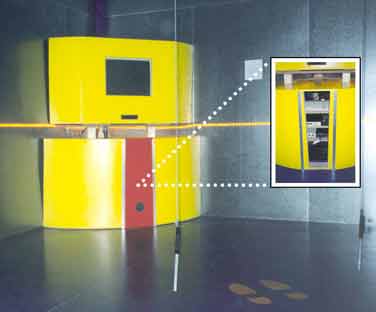| back to index | |||
H14 Invisible Hardware * |
|||
 Hiding WorldBeat hardware. |
|||
|
....you have designed an attractive, interesting user
interface - Innovative Appearance,
- Domain-Appropriate Devices
- Immersive Display, and you now need to decide how to set up your exhibit, what users should see from your
system, and what should be hidden, so that the system does not look
too threateningly complex - Simple Impression.
|
|||
|
* * *
|
|||
| Modern exhibits often feature complicated and expensive
hardware. The user, however, may be driven away by the display of such
technology.
|
|||
| WorldBeat: Hardware hidden in cabinet |
The opening picture shows the WorldBeat system in an exhibition in the Techniek Museum Delft. WorldBeat consists of many technical hardware components, including a computer, MIDI (Musical Instruments Digital Interface) connector, baton interface, pitch-to-MIDI converter, Hi-Fi amplifier, battery charger, various power adaptors, and some 30 m of cabling. It was tempting to show at least some of this technology to the user, to give an impression of the complexity of the system behind the scenes. However, the exhibit was supposed to be about \emph{music}, and it would be hard enough not to scare off people because they expect to need expert musical skills to operate the exhibit. Showing all the technology to them would have, in addition, created the impression that one surely has to be a computer expert to use such a complex system. This would have created a contact threshold for users approaching the system. Therefore, our design went into the opposite extreme, and hid all hardware except what was necessary to run the user interface - infrared batons, infrared tracker and microphone as input, and monitor as output device. The result was that people without any prior computer knowledge used the exhibit confidently, and only after using it, would some more technically minded visitors enquire about the technology at work. |
||
| Film projectors |
This principle has also been expressed by Norman [1988], and he gives a good example of its application. Old film projectors required the user to manually thread the film into the transport mechanism. The complexity of this task was only partially reduced by later threading support mechanisms that still left the task visible. Today's video recorder fulfils a similar task - threading the video tape around the video heads - , but this complex mechanism is hidden completely from the user, who triggers this process by just pushing a video cassette into the recorder. |
||
|
Therefore: Hide as much of the computer-related hardware of your interactive exhibit as possible. Only leave visible those devices that the user has to see, and that generate an image adequate for the application domain of your exhibit. |
|||
 |
|||
|
* * *
|
|||
|
You can reduce the apparent complexity of your system
further by reducing the number of user interface devices - One Input Device.
|
|||
This pattern is taken from the book "A Pattern Approach to Interaction Design" (PAID) by Jan Borchers (John Wiley and Sons, Chichester, UK, 2001). Copyright 2001 John Wiley and Sons. Used by permission. See http://media.informatik.rwth-aachen.de/paid.html for more information. Online version by Susan Babutzka, ETH Zurich (subabutz_at_student.ethz.ch). |
|||